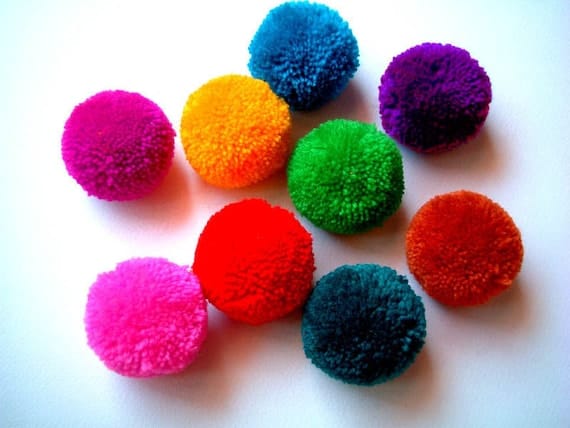Welcome to the Colorful World of Pom Poms!
Hello there, oh marvelous parents! Are you ready to embark on a sparkling journey through the fluffiest corners of creativity with your little ones? Dive with me into the whimsical world of pom poms, where imagination meets craftsmanship and where laughter and learning go hand in hand. Let’s get those creative juices flowing and bring smiles to those cute little faces!
What Are Pom Poms, Exactly?
Oh, what fun these tiny, soft spheres can be! Pom poms are small balls made from yarn, wool, paper, or plastic that come in a kaleidoscope of colors and sizes. Originally used as a decorative element on hats and clothing, pom poms have now become a beloved craft staple, offering endless opportunities for fun and learning. From enhancing fine motor skills to teaching color recognition, pom poms can be your go-to tool for educational play!
DIY Pom Pom Making: A Family Affair
There’s nothing like a bit of DIY magic to bring the family together. Crafting your own pom poms is not only cost-effective but also a fantastic way to bond with your kids. All you need is some yarn and a little bit of patience! We’ll guide you through the simple steps of creating homemade pom poms that can be used in myriad activities. Follow along, and get ready to be the coolest craft-master in town!
Creative Pom Pom Crafts for Kids of All Ages
Whether you’ve got a tenacious toddler or a preteen Picasso, there are pom pom crafts that will tickle everyone’s fancy. From easy-peasy projects for the smallest hands to more intricate designs for older kids, this guide will provide a treasure trove of ideas to keep your family creating for hours on end. Get ready to make pencil toppers, garlands, cute critters, and even your own soft jewelry—the possibilities are endless!
Did you know that crafting with pom poms can help enhance your child’s development? That’s right! By threading, sorting, and sticking pom poms onto various surfaces, kids improve their fine motor skills, hand-eye coordination, and problem-solving abilities. And let’s not forget about the fun factor. Crafting is such a joyous activity, and when pom poms are involved, it’s practically impossible not to have a blast.
Now, gather your crafting supplies, and let’s leap into some jolly good pom pom fun!
Educational Pom Pom Activities for Enhancing Learning
Look no further, dear parents, for we have educational activities that will light up your child’s intellect like a festive pom pom garland! Think of these soft, tiny spheres as sponges of knowledge, ready to soak up and teach all sorts of valuable lessons. From color sorting games to math exercises, we’ll explore how you can incorporate these versatile tools into your child’s learning regimen in the most delightful way.
With our guide, soon you’ll be crafting and learning with pom poms, creating beautiful memories and even more beautiful masterpieces. Brighten up your days, as these cheerful little puffs add splashes of color and doses of learning to your family routine. Stay tuned for more inspirational ideas and step-by-step tutorials that will make pom poms your new best friend in both education and fun!

5 Essential Things Parents Should Know Before Starting Pom Pom Crafts
1. Choose the Right Materials
Before you dive into the frilly fun, ensure you have the right materials. Yarn pom poms are traditional and easy to make, but for young children, consider using tissue paper or pre-made pom poms from craft stores to avoid tangles and frustration. Opt for child-safe scissors and non-toxic glues to keep crafting sessions safe and worry-free.
2. Prep Your Space
Crafting can get messy, especially with exuberant little crafters at work! Prepare a crafting area that’s easy to clean. Lay down newspaper, a wipeable tablecloth, or a craft mat to catch stray bits of yarn or drops of glue. A well-organized space is crucial for keeping tiny pom poms from rolling into the abyss of no return.
3. Patience is Key
Creating pom poms can test the patience of both kids and adults, especially if you’re making them from scratch. Start with simple projects and expect a learning curve. Remember, it’s not about perfection; it’s about the fun and experience. Celebrate effort as much as the end result to encourage your little ones.
4. Embrace the Learning Opportunities
Pom pom crafting is more than just fun—it’s a treasure trove of educational benefits. Use the variety of colors and sizes to discuss concepts like counting, colors, and patterns. Encourage your child to follow instructions for a project, enhancing their listening and executive functioning skills.
5. Get Creative with Storage Solutions
You’ll quickly find that pom poms have a way of multiplying! Keep them organized by color or size in clear containers, zip-locked bags, or upcycled jars. Teach your children to sort and store their pom poms, reinforcing the importance of tidiness and responsibility after crafting sessions.
Crafting Safely and Responsibly with Pom Poms
Whilst pom pom crafting is heaps of fun, it’s important to craft responsibly. Always supervise children to avoid any accidental ingestion or misuse of crafting tools. Ensure that all materials used are appropriate for your children’s age group and always store sharp objects out of reach when not in use.
So, adorable parents, are you feeling ready to kickstart the pom pom party? With these simple preparations in place, you and your children are all set to start rolling out those darling little spheres of joy. Just imagine the cute projects, the joyous laughs, and the proud moments that await with each pom pom creation. Happy crafting, and remember: every pom pom is a tiny bundle of potential, waiting to be transformed into something uniquely wonderful by you and your kiddos!
For more great fun click here. For more information see here
Disclaimer
The articles available via our website provide general information only and we strongly urge readers to exercise caution and conduct their own thorough research and fact-checking. The information presented should not be taken as absolute truth, and, to the maximum extent permitted by law, we will not be held liable for any inaccuracies or errors in the content. It is essential for individuals to independently verify and validate the information before making any decisions or taking any actions based on the articles.




